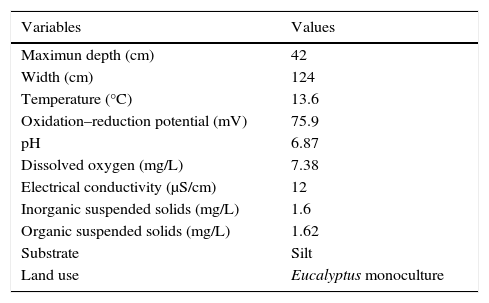Albinism is a genetic condition caused by an autosomal recessive gene that affects normal pigmentation in animals. In Neotropical freshwater fish fauna, albinism cases are extremely rare, with only 14 species recorded among more than 6000 described. Here, we describe the first reported case of albinism in the South American catfish Imparfinis mirini. The albino fish was collected in July 2016 with a seine net in a stream in southeast Brazil. Although albinism can decrease the chance of fish survival, the cryptic and nocturnal habits of this species and the low amount of piscivorous fish and birds in the stream may have favored its growth. Two possible explanations for the appearance of the albino fish are discussed: a genetic disorder caused by heavy metal contamination and the high endogamy rate in the fish population which could increase the chances of appearing deleterious genes.
El albinismo es una condición genética causada por un gen autosómico recesivo que afecta a la pigmentación normal en los animales. En la fauna de peces de agua dulce neotropicales, los casos de albinismo son extremadamente raros, con solo 14 especies registradas entre más de 6000 descritas. Se expone el primer caso documentado de albinismo en el bagre sudamericano Imparfinis mirini. El pez albino fue recolectado en julio de 2016 con una red de cerco en un arroyo en el sureste de Brasil. Aunque el albinismo puede disminuir la probabilidad de supervivencia de los peces, los hábitos crípticos y nocturnos de esta especie y la baja cantidad de peces y aves piscívoras en los arroyos pueden haber favorecido su crecimiento. Se examinaron 2 posibles explicaciones para esta condición: un trastorno genético causado por la contaminación por metales pesados y la alta tasa de endogamia en la población de peces, que podría aumentar las posibilidades de aparición de genes deletéreos.
Albinism is a genetic condition caused by an autosomal recessive gene that affects normal pigmentation in animals (Oliveira & Foresti, 1996). The total albinism can occur in all vertebrates groups and it is characterized by whitish body and the presence of red eye (Sazima & Pombal Jr., 1986), whereas partial albinism, also known as leucism, is characterized by presence of pigmentation in only some body parts (Lutz, 2001).
In Neotropical freshwater fish fauna, albinism cases are extremely rare, with only 14 species recorded (Nobile, Freitas-Souza, Lima, Acosta, & Silva, 2016) among more than 6000 described (Reis, Kullander, & Ferraris, 2003). Of these species, 11 belong to the order Siluriformes, with representatives of Callichthyidae, Doradidae, Loriicaridae and Pimelodidae families (Nobile et al., 2016).
Albinism in fish can be related to 3 different situations: heredity (Ueda, Ishinabe, & Jeon, 2007), contamination by heavy metals (Oliveira & Foresti, 1996) and artificial selection by aquarists (Sazima & Pombal Jr., 1986). Apart from the pigmentation differences, albino fish also show behavioral differences as lower aggressiveness and reduced shoaling behavior preference (Slavík, Horký, & Wackermannová, 2016).
Imparfinis mirini is a South American catfish that belongs to Heptapteridae family, which can reach up to 8.5cm of SL and is widely distributed in the Upper Araguaia and Paraná River basins (Bockmann & Guazzelli, 2003). It inhabits streams with substrates composed mostly of boulders, gravel or sand, which speculates using their barbells as sensory organ to feed on juvenile aquatic insects, especially Diptera, Trichoptera and Ephemeroptera (Casatti, Langeani, & Castro, 2001).
In July 2016, we collected a totally albino specimen of I. mirini (SL 37mm) with a seine net in a second order stream (23°2′18″ S, 48°39′36″ W) which belongs to the Rio Pardo basin, Itatinga, São Paulo (Fig. 1). In the same site, we collected more than 50 conspecifics animals with normal pigmentation. The environmental characteristics of the site are in Table 1. The albino specimen was deposited in the “Coleção do Laboratório de Biologia e Genética de Peixes”, UNESP, Botucatu (Voucher: LBP-22256).
Values of stream's environmental variables sampled in the local where the albino specimen of Imparfinis mirini was collected.
| Variables | Values |
|---|---|
| Maximun depth (cm) | 42 |
| Width (cm) | 124 |
| Temperature (°C) | 13.6 |
| Oxidation–reduction potential (mV) | 75.9 |
| pH | 6.87 |
| Dissolved oxygen (mg/L) | 7.38 |
| Electrical conductivity (μS/cm) | 12 |
| Inorganic suspended solids (mg/L) | 1.6 |
| Organic suspended solids (mg/L) | 1.62 |
| Substrate | Silt |
| Land use | Eucalyptus monoculture |
The Heptapteridae family are mostly cryptic and nocturnal fish (Reis et al., 2003), which allows the species without pigmentation be less susceptible to predation by visual oriented predators and recognition by their preys (Sazima & Pombal Jr., 1986). Furthermore, in headwater streams there are lower amounts of piscivorous fish and birds (Uieda & Motta, 2007), which may favor the growth of the albino fish.
In vertebrates, albinism is caused by an autosomal recessive gene (Smallcombe, 1949), therefore, a possible explanation for the occurrence of total albinism in this individual could be the presence of deleterious genes caused by the high endogamy rate in small isolated populations (Peltonen, Palotie, & Lange, 2000), such as in fish found in headwaters (Clarke, MacNally, Bond, & Lake, 2008).
Another possible explanation may be related to a genetic disorder caused by heavy metal contamination, as shown in streams located in eucalyptus monocultures suffer contamination of their substrate by Cadmium and Chromium (Baggio & Horn, 2009).
We thanks to Estação Experimental de Ciências Florestais de Itatinga – ESALQ/USP for allowing us access to the stream, to Coordenadoria de Aperfeiçoamento de Pessoal de Nível Superior (CAPES) for the first author's scholarship, to ICMBIO for the collection permit (SISBIO: 52777-1) and to Silvio César de Almeida for helping us with the fieldwork.
Peer Review under the responsibility of Universidad Nacional Autónoma de México.






